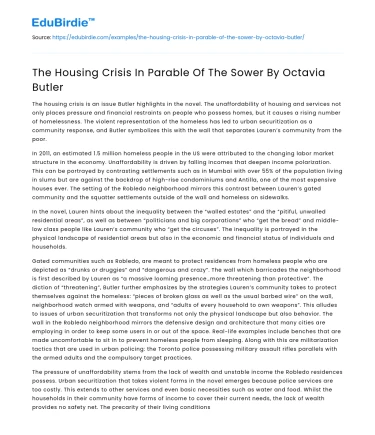The housing crisis is an issue Butler highlights in the novel. The unaffordability of housing and services not only places pressure and financial restraints on people who possess homes, but it causes a rising number of homelessness. The violent representation of the homeless has led to urban securitization as a community response, and Butler symbolizes this with the wall that separates Lauren’s community from the poor.
In 2011, an estimated 1.5 million homeless people in the US were attributed to the changing labor market structure in the economy. Unaffordability is driven by falling incomes that deepen income polarization. This can be portrayed by contrasting settlements such as in Mumbai with over 55% of the population living in slums but are against the backdrop of high-rise condominiums and Antilla, one of the most expensive houses ever. The setting of the Robledo neighborhood mirrors this contrast between Lauren’s gated community and the squatter settlements outside of the wall and homeless on sidewalks.
Save your time!
We can take care of your essay
- Proper editing and formatting
- Free revision, title page, and bibliography
- Flexible prices and money-back guarantee
In the novel, Lauren hints about the inequality between the “walled estates” and the “pitiful, unwalled residential areas”, as well as between “politicians and big corporations” who “get the bread” and middle-low class people like Lauren’s community who “get the circuses”. The inequality is portrayed in the physical landscape of residential areas but also in the economic and financial status of individuals and households.
Gated communities such as Robledo, are meant to protect residences from homeless people who are depicted as “drunks or druggies” and “dangerous and crazy”. The wall which barricades the neighborhood is first described by Lauren as “a massive looming presence…more threatening than protective”. The diction of “threatening”, Butler further emphasizes by the strategies Lauren’s community takes to protect themselves against the homeless: “pieces of broken glass as well as the usual barbed wire” on the wall, neighborhood watch armed with weapons, and “adults of every household to own weapons”. This alludes to issues of urban securitization that transforms not only the physical landscape but also behavior. The wall in the Robledo neighborhood mirrors the defensive design and architecture that many cities are employing in order to keep some users in or out of the space. Real-life examples include benches that are made uncomfortable to sit in to prevent homeless people from sleeping. Along with this are militarization tactics that are used in urban policing: the Toronto police possessing military assault rifles parallels with the armed adults and the compulsory target practices.
The pressure of unaffordability stems from the lack of wealth and unstable income the Robledo residences possess. Urban securitization that takes violent forms in the novel emerges because police services are too costly. This extends to other services and even basic necessities such as water and food. Whilst the households in their community have forms of income to cover their current needs, the lack of wealth provides no safety net. The precarity of their living conditions has implications to their economic well-being but also social life and this is evident. This mirrors the rise of precarious work in the ‘Postindustrial’ urbanism era.
To conclude, the housing crisis Butler portrays is an extreme depiction of contemporary urban issues. The symbolic wall and defensive behavior Robledo has towards homeless people represent urban securitization. Unaffordability of services and basic necessities arise because of deepening income polarization that resulted from economic crises like unemployment.
Did you like this example?
Make sure you submit a unique essay
Our writers will provide you with an essay sample written from scratch: any topic, any deadline, any instructions.
Cite this paper
-
APA
-
MLA
-
Harvard
-
Vancouver
The Housing Crisis In Parable Of The Sower By Octavia Butler.
(2021, September 20). Edubirdie. Retrieved December 25, 2024, from https://edubirdie.com/examples/the-housing-crisis-in-parable-of-the-sower-by-octavia-butler/
“The Housing Crisis In Parable Of The Sower By Octavia Butler.” Edubirdie, 20 Sept. 2021, edubirdie.com/examples/the-housing-crisis-in-parable-of-the-sower-by-octavia-butler/
The Housing Crisis In Parable Of The Sower By Octavia Butler. [online].
Available at: <https://edubirdie.com/examples/the-housing-crisis-in-parable-of-the-sower-by-octavia-butler/> [Accessed 25 Dec. 2024].
The Housing Crisis In Parable Of The Sower By Octavia Butler [Internet]. Edubirdie.
2021 Sept 20 [cited 2024 Dec 25].
Available from: https://edubirdie.com/examples/the-housing-crisis-in-parable-of-the-sower-by-octavia-butler/
copy






 Stuck on your essay?
Stuck on your essay?

